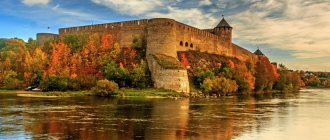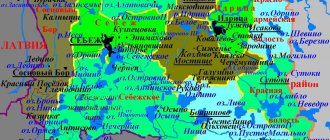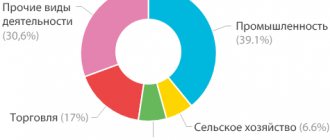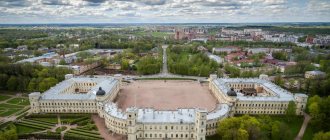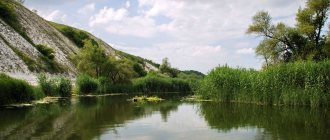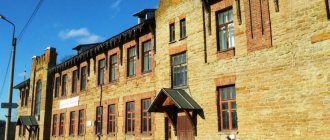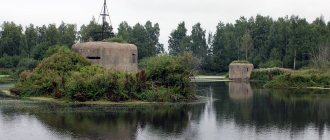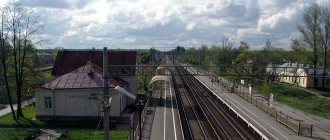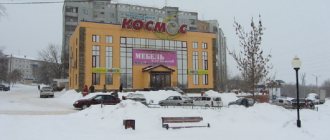The mysterious nuclear town of Sosnovy Bor is ready to share its secrets with all tourists who come here. There are only 20 nuclear cities in Russia, and the gates of some of them remain closed to guests. In 2013, restrictions on access to Sosnovy Bor for Russian citizens were lifted. They only need to present their passport upon entry. Citizens from other countries who want to get acquainted with the life and living conditions of Russian scientists and nuclear scientists need to apply for special passes. These issues are dealt with by travel agencies offering excursion tours around the Leningrad region.
Unlike many Russian cities, Sosnovy Bor leads the region in terms of average wages. This is not a poor city, so you should be prepared for inflated prices for accommodation, food and services. Although here you can arrange a budget holiday for yourself, in particular, not hotels, but a hostel, not restaurants, but cafes, not taxis, but public transport. There is something to see, something to be surprised by, and where to entertain the children. We offer an impromptu tour of the most significant sights of the city and its surroundings, which can be visited in one day
Sights of the city of Sosnovy Bor
The youngest city in the Leningrad region, despite its age, has many interesting places on its streets and surroundings. Among them are the following attractions:
- Museums: naval, modern art, history of Vladimir Antoninov.
- Temples: Cathedral of the Icon of the Mother of God "Burning Bush", St. Nicholas the Wonderworker, Alexander Nevsky, chapel, St. Panteleimon. The churches of St. Seraphim of Sarov and St. Lazarus are being designed and built.
- A children's center that has become the pearl of the city. "Andersengrad".
- Koporye Fortress, famous fort "Red Hill"
- Petrov's merchant house , Elevatsiya ranch.
A map of Sosnovy Bor with houses helps you quickly find any attraction.
Links[edit]
Notes[edit]
- ^ abcde Area Law No. 32-oz.
- ^ a b c Science cities: Sosnovy Bor (in Russian). Federal State Budgetary Institution Research Institute RINKCE. Retrieved March 18, 2013.
- ^ a b Federal State Statistics Service (2011). “All-Russian Population Census 2010. Volume 1" [All-Russian Population Census 2010, vol. 1]. All-Russian Population Census 2010 [All-Russian Population Census 2010]
. Federal State Statistics Service. - "26. The size of the permanent population of the Russian Federation by municipalities as of January 1, 2022". Federal State Statistics Service. Retrieved January 23, 2022.
- ^ abc Provincial Law No. 22-oz.
- "On the Calculation of Time". Official Internet portal of legal information
. June 3, 2011. Retrieved January 19, 2022. - Post office. Information and computing center of OASU RPO. ( Post office
).
Search for postal service objects ( postal Search for objects
) (in Russian) - Leningrad region (in Russian). Russian telephone codes. Retrieved March 22, 2013.
- ↑
Federal State Statistics Service of Russia (May 21, 2004).
“The population of Russia, the constituent entities of the Russian Federation as part of federal districts, urban settlements, settlements, settlements is 3 thousand or more people” [Population of Russia, its federal districts, federal districts, districts Urban settlements, rural settlements - administrative centers and rural settlements with a population of over 3,000] (XLS). All-Russian Population Census 2002
. - “All-Union Population Census of 1989. The current population of union and autonomous republics, autonomous regions and districts, territories, negative phenomena, urban settlements and rural district centers” [All-Union Population Census of 1989: current population of union and autonomous republics, Autonomous regions and districts , territories, regions, districts, towns and villages performing the functions of district administrative centers. All-Union Population Census of 1989 [All-Union Population Census of 1989]
.
Institute of Demography of the National Research University: Higher School of Economics [Institute of Demography of the National Research University: Higher School of Economics]. 1989 - via Demoscope Weekly
. - Oranienbaumsky district (Aug. 1927 - Feb. 1948), Lomonosovsky district (Feb. 1948 - Feb. 196Z, Jan. 1965) (in Russian). System of classifiers of executive bodies of state power of St. Petersburg. Retrieved March 13, 2013.
- "Leningrad 2nd plant begins to provide centralized heat supply". World nuclear news. December 2, 2022. Retrieved December 3, 2022.
- NITI im. A.P. Alexandrova (in Russian). NITI im. A.P. Alexandrova. Retrieved March 24, 2013.
- Northwestern Territorial District (in Russian). FSUE "RosRAO". Archived from the original on April 26, 2012. Retrieved March 24, 2013.
Sources [edit]
- Legislative Assembly of the Leningrad Region. Regional Law No. 32-oz of June 15, 2010 “On the administrative-territorial structure of the Leningrad region and the procedure for changing it,” as amended. Regional Law No. 23-oz dated May 8, 2014 “On the merger of municipalities” Primorskoye urban settlement of the Vyborg district of the Leningrad region and Glebychevskoye rural settlement of the Vyborg district of the Leningrad region and on amendments to certain Regional laws. Came into force on the date of official publication. Published: “Vesti”, No. 112, June 23, 2010 (Legislative Assembly of the Leningrad Region. Regional Law of June 15, 2010 No. 32-oz “ On the administrative-territorial structure of the Leningrad Region and the procedure for changing it”
, As amended by the Regional Law dated 05/08/2014 No. 23-oz.
On the annexation of the municipalities "Urban settlement Primorskoye" in the Vyborg district of the Leningrad region and the "Glebychevskoye rural settlement" in the Vyborg district of the Leningrad region and on amendments to various regional laws
. Valid from the date of official publication.) . - Legislative Assembly of the Leningrad Region. Regional Law No. 22-oz of March 31, 2005 “On establishing the boundaries of the municipal formation of Sosnovoborsky Urban District,” as amended. Regional Law No. 17-oz dated May 6, 2010 “On amendments to some regional laws in connection with the adoption of the federal law “On amendments to certain legislative acts of the Russian Federation in connection with improving the organization of local self-government””. Came into force 10 days from the date of official publication (May 14, 2005). Published: “Bulletin of the Government of the Leningrad Region”, No. 15, May 4, 2005 (Legislative Assembly of the Leningrad Region. Regional Law of March 31, 2005 No. 22-oz “ On establishing the boundaries of the municipal formation of the Sosnovoborsky urban district”).
As amended by the Regional Law of May 6, 2010 No. 17-oz “
On amendments to various laws of the region in connection with the adoption of the Federal Law “On amendments to certain legislative acts of the Russian Federation in order to improve the organization of local self-government.”
-Government " . Valid after 10 days from the date of official publication (May 14, 2005).
Main streets of Sosnovy Bor
The main streets of the city are the following:
- Afanasyeva. The street is named in honor of the hero of the Soviet Union of the Great Patriotic War, Captain I.I. Afanasyev, born in the village of Ustye (which became part of the city). At 50 Afanasyeva Street there is a naval museum.
- Komsomolskaya. The young city was built thanks to the youth who arrived on Komsomol vouchers, living in iron trailers at the station, barracks, and tents set up on the banks of the Kovashi River. One of the city streets is named in honor of their hard work. (The first street of the village is Leninskaya Street).
- Leningradskaya. The name reflects the spirit of the times, the connection with the most important center, the city of Leningrad. The merchant house of Petrov is located on it. Simple from the outside, it amazed with the rich decoration of the interior rooms, reminiscent of the chambers of palaces. On the street there are the Koporye Fortress and the Museum of Modern Art.
- Academician Alesandrov. The name of the street and the bronze bust are associated with the name of the founder of NITI, who gave life to Atomgrad.
- Avenue of Heroes. It runs from Leningradskaya Street to Alexander Nevsky Avenue. It houses the Cathedral of the Icon of the Mother of God “The Burning Bush”.
- Embankment. It runs along the bank of the Voronka River.
- Rakopezhskoe highway.
History[edit]
It was founded in 1958 as an urban settlement serving the Leningrad Nuclear Power Plant, and received the status of an urban settlement on December 10, 1958. [11] At that time it was part of the Lomonosovsky district of the Leningrad region. On April 19, 1973, Sosnovy Bor received city status and became a city of regional significance, after which it ceased to be part of the Lomonosovsky district. [2]
Chronology[edit]
| In this section do not cite any sources . |
- 1958 - Sosnovy Bor was founded.
- 1961 A branch of the Leningrad special-purpose plant “Radon” was created. Today it is a state corporation for the collection, processing and long-term storage of radioactive waste.
- 1962 The State Station for Testing Marine Nuclear Power Plants was created as a branch of the Kurchatov Institute of Atomic Energy (IAE). In 1966 it became the Scientific Research Technological Institute (NITI).
- 1963 A branch of the State Optical Institute named after. S.I. Vavilova.
- 1966 The Northern Construction Directorate, SUS, was created. His main goal was the construction of the Leningrad Nuclear Power Plant.
- On April 19, 1973, Sosnovy Bor was given city status. This date is now a city holiday.
- December 23, 1973 The first reactor of the Leningrad Nuclear Power Plant produced its first power.
- 1981 Launch of the fourth LNPP reactor. Leningrad NPP became the world's largest nuclear power plant (4 GW)
- 1996 First mayor elected.
The heraldist deciphered the coats of arms of Luga, Vyborg and Sosnovy Bor
Why is there salmon on the coat of arms of Luga? Gatchina and Vyborg: who spied the letter on whose coat of arms? Gleb Kalashnikov, executive secretary of the Heraldic Council under the President of Russia, told about this to the hosts of the podcast “UFO-Unknown Leningrad Region” Natalya Kostitsina and Kirill Manzhula.
UFO: Has the current coat of arms of Vyborg come down to us from the Middle Ages?
G.K.: Absolutely right. Although, of course, it is already from the turn of the Middle Ages of modern times and dates back to the end of the 15th century, to the 1480s. In this sense, by the way, the coat of arms of Vyborg is almost the same age as our state coat of arms, a little older by a couple of decades. This coat of arms is really interesting and even very interesting, since in fact it is a coat of arms of the decline, perhaps, of the golden age of heraldry, the decline of knightly culture, and still fully responds to the special position of Vyborg, the special position of how this city arose, on what rights and in what meaning it existed in Sweden. The history of the emergence of Vyborg is, in general, ordinary, but quite interesting. That is, this is a so-called “artificial city”, that is, a city that did not develop in this place on its own, but was created by the authorities for a specific purpose. The goal was very simple: it was necessary to defend the eastern borders of the Kingdom of Sweden from Novgorod, because the neighbor was restless. Both the Novgorodians and the Swedes went to the Novgorodians with war all the time.
UFO: Did the Vyborg coat of arms somehow influence the design of other coats of arms?
G.K.: Yes, definitely. He has a twin brother in our region, or rather, his heir in his idea. Although, again, this is not stated in any documents, and one can only guess. But the similarity is so obvious that it cannot be accidental. I'm talking about the coat of arms of Gatchina. Remember, it’s also a shield in half, on top there is a double-headed eagle on a golden field, that is, the state coat of arms, and below is the Latin letter G. This is probably an absolutely non-random decision, because this coat of arms was granted by Emperor Paul I. Before Paul’s accession to the throne, Gatchina had city rights didn’t have one, was a village. Paul made his favorite residence a city and gave it a coat of arms. Moreover, in all likelihood, he was directly involved in its preparation and probably suggested the idea. Considering Paul's passion for knightly culture.
UFO: Are there any objects from the world of flora or fauna on the coats of arms of the Leningrad region?
G.K.: You know, in fact, one can be curiously combined with the other. For example, Priozersk-Kexholm. His coat of arms is two-part, at the top is the coat of arms of Karelia of Swedish origin, and the central figure in the coat of arms is two hands with sabers facing each other. This is a Swedish variation, when one hand should be in chain mail and with a curved saber, and the other in armor and with a straight sword. That is, there is clear contact between Novgorod and Sweden. Yes, later just two hands began to be often used with this weapon, and below there is a representative of the fauna, that is, a crane with a pebble in its hand. But this representative of the fauna can also be interpreted as a military symbol, because it is such a common symbol of vigilance.
UFO: But the coat of arms of Luga depicts a salmon?
G.K.: Absolutely right. The Luga coat of arms is very simple and it is just a salmon. He is also from Catherine’s times. Under Catherine II, during her great reform of territorial administration, when the territorial division that had existed until the end of the empire was cut, that is, provinces divided into districts, we created a huge number of cities, because each district needed a city. And plus, it was then decided that every city must have a coat of arms. At that time, few cities had their own coats of arms. And the government was faced with the task of inventing a large number of coats of arms in a short time. And it was an unfortunate coincidence that at that moment our heraldic department was headed by a very diligent, executive official, but a man who understood nothing about heraldry and had no heraldic taste. He diligently read several books, found some more or less passable draftsmen, did his job very honestly, but it was clearly not his job. It was a king of arms named Volkov, a very worthy man. And plus he acted very artlessly. Local history questionnaires with a large number of questions were sent to all cities, where local authorities had to write down everything that is interesting in this city. It’s clear how we carry out orders from the center, especially if we need to take the initiative. A bunch of questionnaires have been preserved, on which it is simply written: “There is nothing noteworthy in our city.” And the questionnaire received from the city of Luga was also extremely stingy, and it was very difficult to get anything out of there. It was only mentioned that its inhabitants fished salmon in abundance. Very well. So they put the salmon there.
UFO: As a heraldist, do you have the most favorite, most interesting, from the point of view of nuances and some handicraft things, coat of arms in the Leningrad region?
G.K.: Maybe I’ve been doing this too much and for too long, all my life, so it’s very difficult for me to somehow divide the coats of arms. I think no. In general, each of them is interesting. Our region, by the way, is lucky in this sense. Even our modern coats of arms are all very interesting.
UFO: Is there any mention of a nuclear power plant in the modern coat of arms of Sosnovy Bor?
G.K.: There is an atomic nucleus there. There are fish there too. This is a rather complex coat of arms. And, by the way, there is an oblique Ingria wall on it, because this city stands on the territory, in the very heart, of Ingria. It is also an interesting coat of arms in its own way, incorporating both modern and very old motifs.
UFO: Does this mean that modern heraldry allows the use of signs that literally just appeared, as they say, in the 20th century?
G.K.: You know, of course, heraldry has a bad attitude towards introducing some modern styles and some modern signs. And the point here is not some kind of conservatism, but precisely the durability of the coats of arms. We must operate with signs that will definitely not change their shape for at least 200-300 years.
Listen to the entire 30-minute conversation with the executive secretary of the Heraldic Council under the President of Russia, Gleb Kalashnikov, on the “UFO-Unknown Leningrad Region” podcast.

